- Home
- Encyclopedia
- Boom, Bust and After: Life In The Salt Creek Oi...
Boom, Bust and After: Life in the Salt Creek Oil Field
Nov. 19, 1925, was a cold night for football in the oil boomtown of Midwest, Wyo. “Don’t Miss It,” the Casper Herald had advised the day before. “Something New, Football at Night, Casper vs. Midwest.”
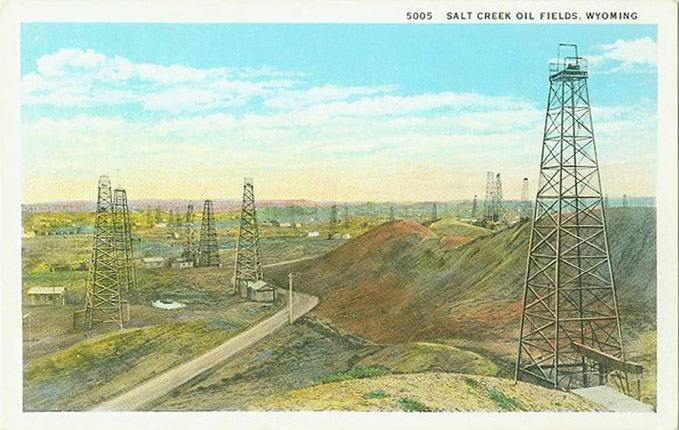
“Floodlights,” the advertisement continued, would be “assisted by open gas flares for light and warmth—the roads are fine …” Fine perhaps, but still dirt in 1925. Midwest is 40 miles north of Casper.
For the football game, Midwest Refinery Company electricians set up 12 floodlights of 1,000 candlepower each around the field, four more of 2,000 candlepower, and from the top of an oil derrick near the field, a huge searchlight swung its beam over the players and the crowd. Electricity had come to the oil fields around Midwest earlier that year, when the company built an electric plant to power thousands of oil-well pumps.
The football was white. The spectators jumped and hopped to stay warm in the frosty air. More than 1,000 people turned out for the game, most of them from Midwest and the other oil camps nearby. A few drove out from Casper on the dirt roads. People in the crowd “were stirred with the giant outdoor overhead lighted drama,” the company magazine noted, “with every play and every player brought out in cameo clearness, reminding all of nothing ever witnessed before.”
It was not the first lighted football game ever. But most likely it was the first night football game ever played in the West, and the first ever played between high school teams. The company cooperated with Midwest High School so oilfield workers could see a game. Working all the time, they generally couldn’t make it to games played in daylight. Casper won, 20-0.
The Salt Creek Oil Field
Midwest sits on high ground above Salt Creek, in the middle of the Salt Creek Oil Field, an oval-shaped piece of central Wyoming 10 miles long and five miles wide. People had been extracting oil from the ground there since 1889: a trickle at first, and then a river, and now a flood. Midwest was booming. The crude oil was pumped out of the ground and piped to Casper, where it was refined into gasoline and other products. Then the oil was shipped out on the railroad.
No one knew it at the football game, but the flood of oil would gradually subside. In the mid-1920s there may have been as many as 10,000 people living in the orderly company town of Midwest and in the messier oil camps scattered nearby. Hard to imagine now, when Midwest has fewer than 500 people.
Like so many oil fields, gas fields and mines in Wyoming, the Salt Creek field boomed, then busted. The bust was never complete, though. For 117 years, the oil has kept right on coming out of the ground. The Salt Creek field is one of the longest continually producing oil fields in the world.
Early discoveries
Salt Creek starts about 20 miles north of Casper and runs forty miles farther north, where it flows into the Powder River near Sussex, Wyo. Indians knew for a long time that black oil could be found floating on the surface of the creek at several spots, especially a place called Jackass Springs.
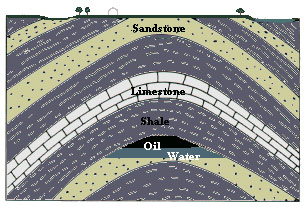
White people may first have learned of the oil when American Indians brought some to Fort Fetterman, on the North Platte River 50 miles east of what’s now Casper, to sell for horse ointment and wagon grease. A Laramie lawyer named Stephen Downey filed some mineral claims around Jackass Springs in 1883, on Salt Creek, a mile or two north of what’s now Midwest. In 1886, Wyoming’s territorial geologist, Samuel Aughey, filed a geological report.
Aughey noticed that the layers of rock around Salt Creek formed an anticline, a place where the layers bend upward, then down again. The layers had been deposited millions of years ago as sand or mud, then hardened into rock. Other pressures in the earth’s crust later bent the layers.
Oil, Aughey knew, is often trapped underground in space left by the up-bent rock. Aughey’s report included a sketch of these layers. It showed that some of the top layers, near the middle of the anticline, were missing. Wind, water and weather had eroded them away. These missing layers explain why the oil, once far underground, was now at the surface.
Cy Iba, a prospector with experience in California and the Black Hills of Dakota, began filing mineral claims along Salt Creek in 1887 and returning every summer to do the required annual work to keep his claims legal. Downey’s claims were absorbed by another group of investors, and they and Iba kept constant watch on each other to make sure the claims stayed up to date. If $100 worth of work wasn’t done on each 20-acre claim each year, another person could legally “jump” the claim—take it over for himself.
Finally, Phillip Shannon, who had learned the drilling business in the oil fields of Pennsylvania, drilled an oil well three miles down Salt Creek from Jackass Springs. It took months. In August 1890, Shannon struck oil when the hole was about 1,000 feet deep. He drilled a few more wells in the next few years.
String teams—teams of 12 to 18 horses or mules pulling a train, or string, of several wagons--freighted the oil to Casper. Each wagon had an oil tank on it. Shannon sold the oil to the railroad for lubricant. By 1895, he had built a small refinery at Casper that produced 15 different kinds of lubricants.
There was not a huge demand for oil yet. It was used mostly to lubricate all kinds of machines or to refine into kerosene, which was used in lamps.
A gusher and a boom
Shannon sold out in 1904 to a group of English, French and Belgian investors. They drilled a well 900 feet deep but the cable broke and the drill bits were lost. In 1907, another group of investors bought all the Iba claims. These ended up in the hands of a Dutch company. The Dutch hit some oil at a depth of 1,050 feet. At 1,092 feet they hit a lot more. A column of oil 100 feet high gushed up from the hole.
With the Dutch gusher, the boom was on. Oil was becoming big business. Automobiles, more popular all the time, ran on gasoline, which was refined from oil. And oceangoing ships were starting to shift from coal to oil-based fuels. Prospectors and investors swarmed to Salt Creek, eager to own all or part of a well that would make them rich.
But the law, written originally to regulate mining of metals like gold, silver and copper, made little sense when applied to oil and led to disputes and confusion. Any group of eight investors could partner up to claim 160 acres, with a different partner’s name attached to each 20-acre piece. Each piece could be held indefinitely, as long as $100 worth of work was done on it each year. Claims were often held for years before the original claimants found investors with enough money and boldness to drill a well—an expensive proposition.
This meant busy work had to be done each year to hold the claim. For example, a pit 10 feet square and five feet deep could count as $100 worth of work, as could a 2-inch hole drilled to a depth of 65 feet. Claimants who failed to do the work risked having the claim jumped. Once oil was struck in moneymaking quantities, claimants could buy the land outright from the government for a price that was low even then--$2.50 per acre.
Then in 1909, the U.S. government’s Department of Interior declared that all unclaimed land around the Salt Creek field would be withdrawn—that is, no new land would be available for claims.
By 1910, some order was beginning to replace the freewheeling confusion. Two main companies emerged. By 1912, the Wyoming Oil Fields Company and the Midwest Oil Company had each built a new refinery in Casper and had laid pipe from the wells on Salt Creek to the new refineries. There were still plenty of smaller outfits around, but the government’s earlier withdrawal meant that there would be no new lands to claim at Salt Creek.
By the end of 1913, the Midwest Refining Company had bought, swapped for or absorbed enough of the other interests that it became the biggest company on Salt Creek. It owned mineral claims, producing wells, pumping stations, pipelines, storage tanks and refineries. Most of its workers lived at the biggest of the camps along Salt Creek—for now still called Home Camp—the town that later would become Midwest.
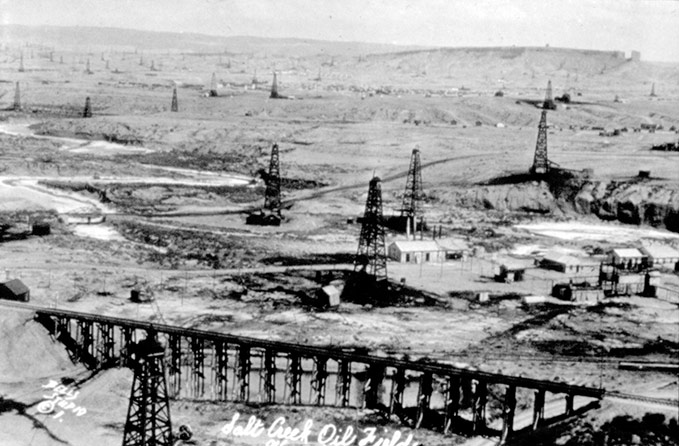
Tom Wall’s jobs
Tom Wall grew up around horses on ranches, but for better wages went to work in the oil field in 1917. His job was to protect Midwest Refining Company claims from claim jumpers. The country was rough. The simplest way to do the job was on horseback. Riders were not allowed to carry guns. No one wanted the conflict to get too serious. Often, it was good natured. Once, Wall remembered later, a company sent 30 men to jump a claim. They found another large group for another company was protecting it. Instead of fighting, the men on both sides slept on the claim, ate, played cards together and drew company wages for several more days.
Wall’s next job was as a tank gauger, measuring or gauging the levels of oil in storage tanks. At the time, oil from various pumping stations around the field was pumped to a central station—Station One. There, it was stored in tanks big enough to hold 65,000 barrels of oil. The oil was then pumped to storage tanks in Casper’s so-called tank farm. The “farm” was an entire hillside south of the North Platte River. In the coming decades it would hold hundreds of oil tanks.
Every hour the men at Station One telephoned Casper to tell how much oil they’d pumped. The men in Casper would reply with how much oil they’d received. This was a way to check for leaks: If no oil was missing, none had leaked.
World War I came along then. Wall was drafted into the U.S. Army. But he never got sent to France. When he returned to Wyoming, he went back to cowboying on the Spectacle Ranch north of the oilfields near Sussex, Wyo., where he’d worked years before. It was a bad time. The summer of 1919 was very dry, leaving the range without much grass. The next winter was very cold. Cattle suffered and died in droves. Ranches went out of business. Discouraged, Wall went back to Salt Creek.
People were now flocking to the oil fields, where the jobs were—not just from Wyoming but from all over the nation and from foreign countries, too. The field was booming.
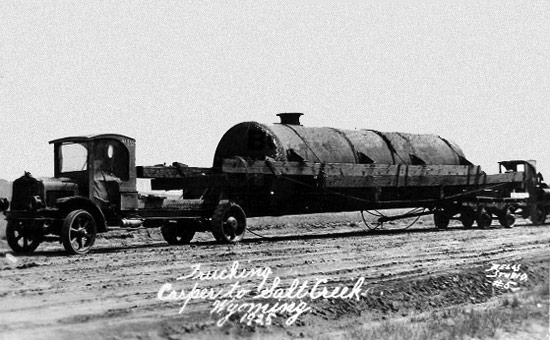
Order in the oil field
In 1920, Congress changed the law to allow the modern system of leasing oil on government land. Companies could now bid on oil leases for specific tracts of government land. The leases would go to the highest bidder. Companies could count on holding the leases for as long as the oil lasted. The business steadied into a more even kind of growth.
Wall, meanwhile, landed another horseback job—riding lines. The oil field was webbed by a network of small pipes, or lines, two inches in diameter. The oil ran from wells to storage tanks and pumping stations. Water that came up out of the ground with the oil ran to tanks and reservoirs. Natural gas ran through lines to fire the boilers that ran the steam engines that powered the drilling rigs. The alkaline soil corroded the pipes, and they sprang leaks. Trucks drove over the pipes, and they broke. Everyone was in such a hurry that no one bothered to take up the pipes once they were no longer needed. Many ran to dead ends. Wall’s job was to ride the field full time, looking for leaks and taking up dead-end lines.
He had a grandstand seat for the oil field. Turning in his saddle, on any clear morning, he saw cars, trucks and horse-drawn wagons coming and going. He saw work crews building derricks, drilling crews drilling wells, gangs of men connecting the lines that seemed to run everywhere. On any given day another well was likely to strike oil. A gusher would spout sometimes higher than the derrick, and the land downwind would turn brown from the oil spray carried on the breeze. He held the job for eight years.
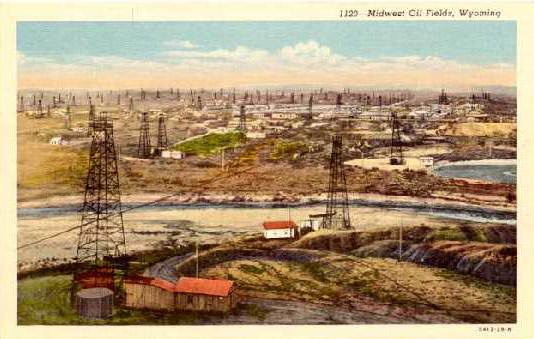
Life in a company town
During that time, the Midwest Oil Company built the company town. No more tents and tarpaper shacks. Single men working for the company could live in six-man bunkhouses, or 50-man boarding houses. Men with families were offered three- or four-room cottages. All were welcome to eat at the Midwest Hotel. Its dining hall routinely served 500 people, three meals a day. Rent and the cost of meals were taken out of the workers’ paychecks.
The company built a movie theatre, a two-story clubhouse and a two-story office building. Several of the companies jointly built a hospital. The Midwest company supplied gas, electricity, good water and incinerators. The company laid in irrigation lines so people could water their lawns, began contests for the most beautiful yards and offered free cottonwood saplings for anyone who wanted to plant trees. In photographs the streets look straight, and the identical houses look freshly painted. Home Camp changed its name to Midwest in 1923. It made sense, as the company owned the town.
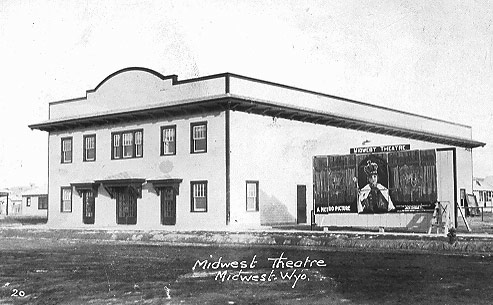
At first, families were rare and most men were single. Children were scarce. The one-room school at Home Camp in 1913 averaged only 20 students. Within ten years, the schools were bursting. A four-room school built in 1922 held 160 students. Two years later a two-story frame high school was built big enough for 200 students. In 1925, students from many of the little schoolhouses in the outlying camps began being bussed in to Midwest. A photo from that year shows about 500 students in front of the Midwest school. A teacherage—a boarding house that could hold 16 single teachers—was finished in 1923.
Wall’s recollections make it seem as though there was an official social life in the company town, and a rougher one in the smaller, outlying camps. The official social life centered on churches, schools and the company clubhouse and dining hall. Prohibition was on, so drinking alcohol was illegal. Company rules forbade drinking and gambling in any case. But both went on in cafes and speakeasies in the smaller camps. And in the hills around the oil field, bootleggers kept stills, made plenty of illegal whiskey and sold it to the men.
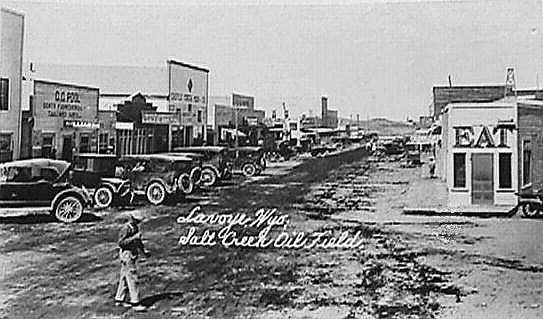
Wall felt lucky all the rest of his life to fall into a friendship with Helen Clarke, one of the teachers who lived at the teacherage. She spent winters in Midwest and returned to her family in Missouri when school let out each summer. One October day in 1928, they traveled together to Casper. Wall bought a Chevrolet, and bought Helen a new diamond ring. “I felt jubilant, but broke,” he remembered. They were married a few weeks later.
A long, slow bust
By that time, drilling of new wells had about ceased in the Salt Creek Field. There were thousands of wells, and the pressure that pushed the oil out of the ground was falling. More and more of the wells needed pumps to keep them flowing. Men began leaving for newer, bigger fields in places like Texas and Montana. The Midwest Refinery Company was bought out by Standard Oil of Indiana. Operating as Stanolind Oil and Gas, the company had taken over all of Midwest’s operations in the field by the end of 1932.
The stock market, meanwhile, crashed in 1929, and the nation slid into the deepest depression it has ever known. Wages fell very low. Job after job disappeared. In 1932, the company stables were torn down, and all its draft teams and saddle horses were sold. Wall moved indoors to a series of clerking jobs, and then, in 1935, back outside to various jobs maintaining the wells and pumps. He felt lucky to have a job at all, “wearing overalls and getting a little grease smeared on me.”
The numbers of barrels of oil produced each year in the Salt Creek field clearly show the boom-bust patterns. In 1922, after the new leasing system came in, and after a new oil-bearing layer had been discovered deeper underground, the field produced 19 million barrels of oil. In 1923, the biggest year, 35.3 million barrels of oil came out of the field. By 1930, production was down to 10.5 million barrels and by 1945, 4.5 million barrels.
As for the town of Midwest, workers were allowed to buy the houses and own them outright beginning in the 1960s, and in 1975, the town, at last, incorporated. People finally could elect their own mayor and town council to govern them.
Still more oil
New laws in the 1930s allowed companies to pool their interests and hire a single company to operate—that is, drill, pump and maintain—an oil field. This made for much more efficient oil production. Stanolind was hired to run the entire field after 1933. Amoco eventually followed Stanolind. In 1997, the Howell Oil Company bought out Amoco’s interests, and in 2002, Anadarko bought out the Howell interests in the field.
The Salt Creek field has produced about 650 million barrels of oil over the last century or more. Anadarko analysts figured there might be 1 billion barrels left in the ground there—but the oil won’t flow under old methods. Instead, Anadarko injected carbon dioxide into the ground. The added pressure from the new gas keeps the oil flowing.
In the spring of 2015, Anadarko sold the field to Texas-based Fleur de Lis energy and its financial partner, Kohlberg Kravis Roberts & Co. for an undisclosed amount. Oil prices at the time had fallen precipitously in the previous six months. Company officials said they were glad to acquire “long-lived assets we look to own and operate.”
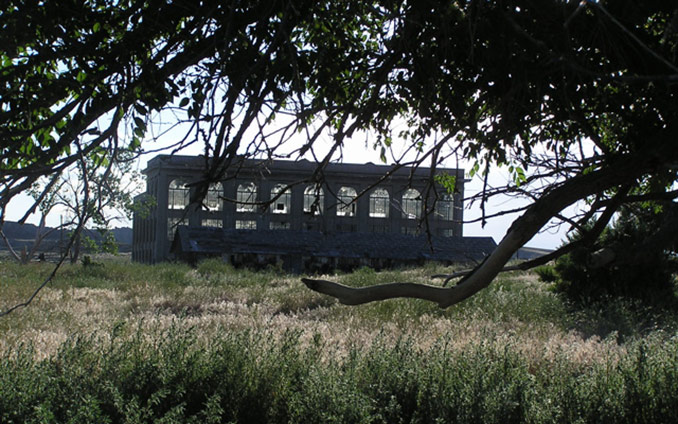
Resources
Primary Sources
- Wall, J. Tom. Life in the Shannon and Salt Creek Oil Fields. Philadelphia: Dorrance & Company, 1973. Though he never says anything critical about the Midwest Oil Company or the Midwest Refining Company, Wall’s memory is long, clear and affectionate. This book is the main source for this account.
- Bille, Ed. Early Days at Salt Creek and Teapot Dome. Edited by Arlene Larson. Artwork by Bill Dickerson. Casper, Wyo.: Mountain States Lithographing, 1978. This book is packed with great photographs. See p. 91 for photos of the night-football teams.
- Prior, F.O. “The Salt Creek Electric Plant.” The Midwest Review, 6, no. 4 (April 1925). A long article on the engineering and construction of the electric plant. The Midwest Review was the company magazine. See back issues at the Casper College Western History Center.
- “Night Football Game in Salt Creek.” The Midwest Review, 6, no. 12, (December 1925).
- Bleizeffer, Dustin. “New Life for Old Field.” Casper Star-Tribune, Jan. 16, 2010. Accessed Jan. 10, 2014 at http://trib.com/news/local/article_16691a67-fff0-5cd9-b61d-3e2dac6bfa50.html.
- Storrow, Benjamin. "Anadarko sells Salt Creek oil field." Casper Star-Tribune, April 2, 2016. Accessed July 28, 2016 at http://trib.com/business/energy/anadarko-sells-salt-creek-oil-field/article_8ac6ddbd-7810-5cac-8ab9-d5d4b0887d68.html.
Secondary Sources
- Mackey, Mike. Black Gold: Patterns in the Development of Wyoming’s Oil Industry. Powell, Wyo.: Western History Publications, 1997.
- “Oil Camp Photos.” Wyoming Tales and Trails, accessed Jan. 10, 2014 at http://www.wyomingtalesandtrails.com/oilcamp.html.
- Roberts, Harold D. Salt Creek, Wyoming: the Story of a Great Oil Field. Denver: Midwest Oil Corporation, 1956.
- Rosenberg Historical Consultants. Tour Guide: Salt Creek Oil Field, Natrona County, Wyoming. Casper, Wyo.: Natrona County Commission, 2003.
- Wyoming State Historic Preservation Office. "Follow the Black Gold Byway," a brochure with historical information on the Shannon, Salt Creek and Teapot Dome oilfields and maps directing drivers to historical markers in Casper, Midwest and Edgerton, Wyo. that deal with the Salt Creek Field and the early oil booms. Accessed March 31, 2014 at http://wyoshpo.state.wy.us/pdf/BlackGoldByway.pdf.
Illustrations
- The color postcards of the Salt Creek field and of Midwest, the diagram of the anticline, the photos of the tank truck, the Midwest theatre and downtown Lavoye are all from Wyoming Tales and Trails, with thanks.
- The black and white photo of the Salt Creek field looking east is by Bell’s Studio, from the Amoco Refining Co. collection, Casper College Western History Center, with permission and thanks.
- The photo of the old Midwest electric plant is by the author.
